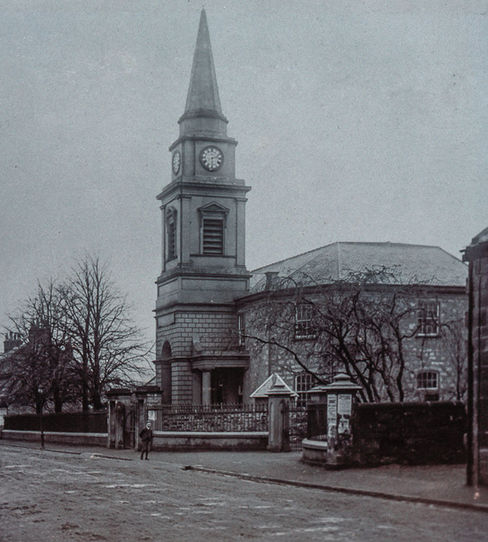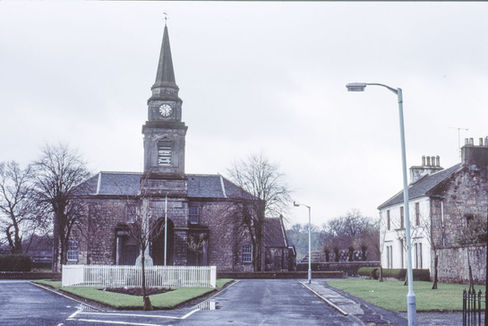top of page


PB the Cairn
Lochwinnoch
The purpose of the site is to help those new to the village to connect with its past and for those who have left for pastures new to remember what was left behind
Lochwinnoch's Churches
Lochwinnoch has had many churches, large and small, over the years.
This page has a selection of the most well known.
The first is the Collegiate Church built by the first Lord Semple in 1505. The first picture provides additional information. The headstones are of subsequent owners of the Castle Semple estate. More will be said about them when the section on Castle Semple estate is added.

Probably the most well known structure in the village - Auld Simon. There is a short video of the inside of the tower and the clock mechanism below.


The Calder United Free Church was originally known as the Burgher Kirk or these days affectionally referred to as the Wee Church.

It was built in 1792. MacDowall provided the land and supported the construction of the Kirk. However, when he found out he would not appoint the minister he withdrew support. The tower was completed in 1815 when the new laird of Castle Semple (John Harvey) donated £50. In 1900 it became part of the United Free Church, a body which had split from the Church of Scotland in 1843. In 1929 when the two parts of the Church re-joined the Calder Church refused and remained a United Free Church.
Further reading. https://www.calderchurch.com
In 1806 the decision was taken to build the Parish Church. Work was completed by 1808. It replaced the church at Auld Simon. A more central church was required due to the significant industrialisation that was going on in the village at that time using the power of the River Calder. In 1812 a petition was raised by John Swan of Wattieston, William Brodie of Kerse, John Stewart of Wateryett, Robert Fleming of Auchengowan, Robert Kirkwood of Langstilly, Allan Pinkerton of Mossend and others in protest at the division of the Church Yard and allotment of seats within the church between the petitioners and all heritors in the parish. Basically the heritors paid for the church and wanted their contributions recognised by the number of seats credited to each of them. On the 3rd of June 1812 the petitioners won their case. I guess this could be viewed as demonstrating either self importance or how important it was to demonstrate your committment to the church at that time.
Rev. Robert Smith (1787-1865) became the minister of the Parish Church in 1815. In 1843 Rev. Smith was one of a large group of minister to leave the Church of Scotland and set up the United Free Church of Scotland. On 14th April 1844 a new church was opened adjacent to the Parish Church, this was to become known as the West Church.
The West United Free Church was built in 1844 just after the split in the Church of Scotland in 1843 known as the Disruption. The split was over whether a wealthy patron (such as Colonel Harvey who was the owner of Castle Semple at this time) had the right to install a minister of his choosing. The reason for the schism ran deeper than this. The right of patronage fed the main bone of contention that the Church should have spiritual independence. The Church of Scotland was the Established church meaning it was sanctioned by the state. However, the Claim of Rights 1689 brought to an end Royal and Parliamentary
interference in the order
and worship of the
church. The right of
patronage was seen to
run counter to this. It
was enshirned in The
Church Patronage
(Scotland) Act 1711 or
Patronage Act which
restored this benefit
after it was removed in
the Glorious Revolution.
The arguement for its
existance was based on
the fact that the main
landowner had an
obligation to provide a
church, burial ground,
relief for the poor and
provide parish schools.
If his nominee was not
accepted the Patron was
entitled to take back the
"donated" property and stipend.
In 1834 the General Assembly passed the Veto Act which gave parishioners the power to reject a minister proposed by their patron. The Court of Session ruled this was Ultra Viris (beyond their power to make such a law). Over the next 10 years matters worsened until in 1843 a substantial number of ministers left and set up the Free Church of Scotland. Those who left forfeited livings, manses and pulpits, and had, without the aid of the establishment, to found and finance a national Church from scratch. In 1874 the patronage that fueled the schicm was abolished by an Act of Parliament. However it was not until 1929 that all issues that led to the split were fully removed and the Church re-united that year.
Rev. Robert Smith was minister from 1844 till 1865 when he died from the after effects of a stroke he suffered 3 years earlier. John Russell became minister on 22nd Feb. 1877. There is a comprehensive biography of Rev. John Russell in Lochwinnoch online (click on his name to go to article). He was succeeded by the Rev. John Blake Russell in 1923 who remained minister till 1946. There are photographs of each of these men in the Lochwinnoch Folk - Past Generation section (click here to see them).
When the Free Church re-joined the Church of Scotland it was decided that one church would go at the first pulpit vacancy. The minister of the re-united churches was Angus Nicolson from 1948 till 1953. The last baptism in the West United Free Church was in 1949.
Lochwinnoch had two places of worship for the Catholic faith. One was within the village at Our Lady of Fatima chapel on the High Street and the second was within the the Mill Hill Seminary (1935-1985) located on the Garthland Estate on the edge of the village known as St Joseph's College. Both are now gone, St Joseph's became a home for the elderly in 1985 and closed in 2004. Pat's mum and my dad were both resident for a while. Our Lady of Fatima chapel was built in 1954 and knocked down in 2018. The red brick chapel at St. Joseph's was opened in 1958. Prior to Our Lady of Fatima local catholic practised their faith at St Joseph's College in the library of the original house which had been converted to a chapel.

Churches Page
bottom of page
















































